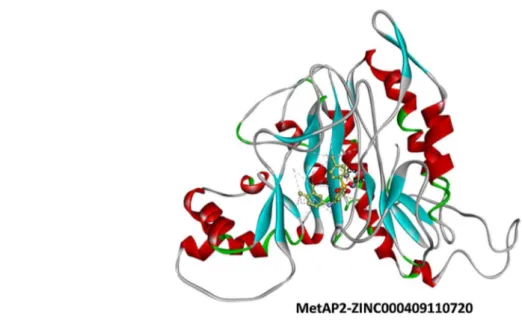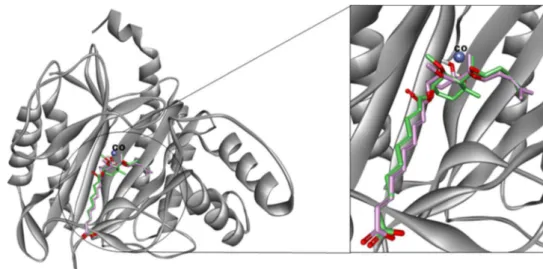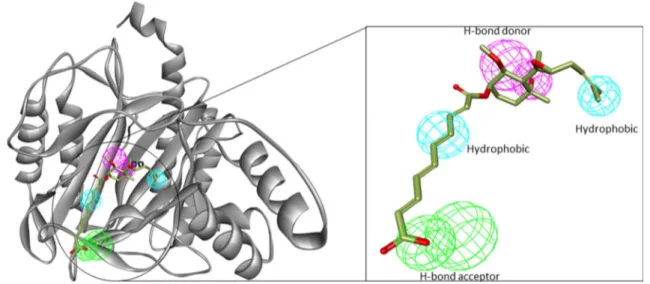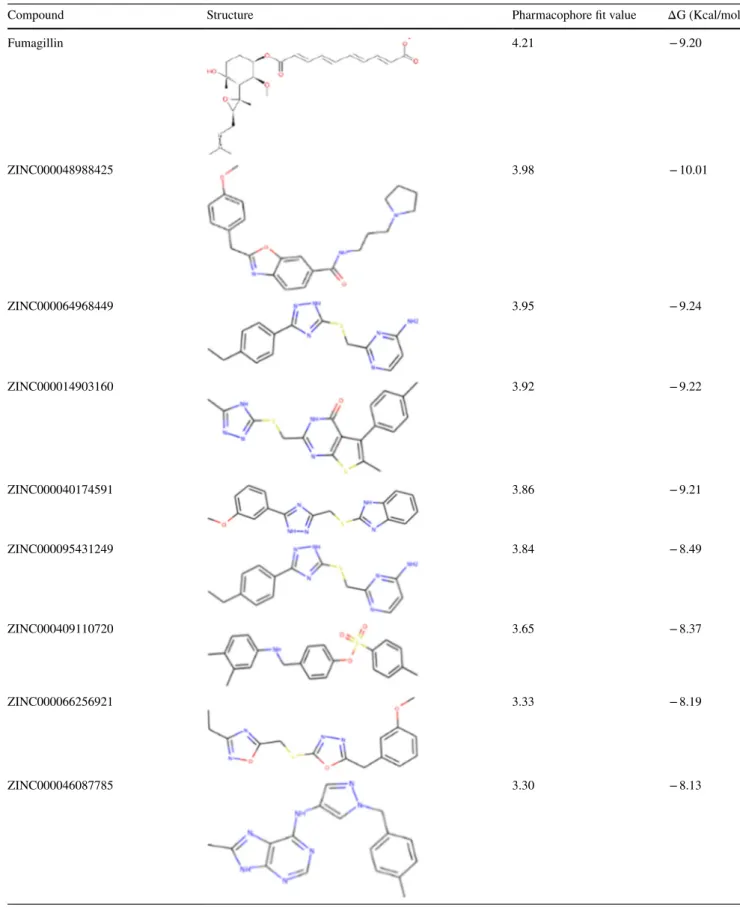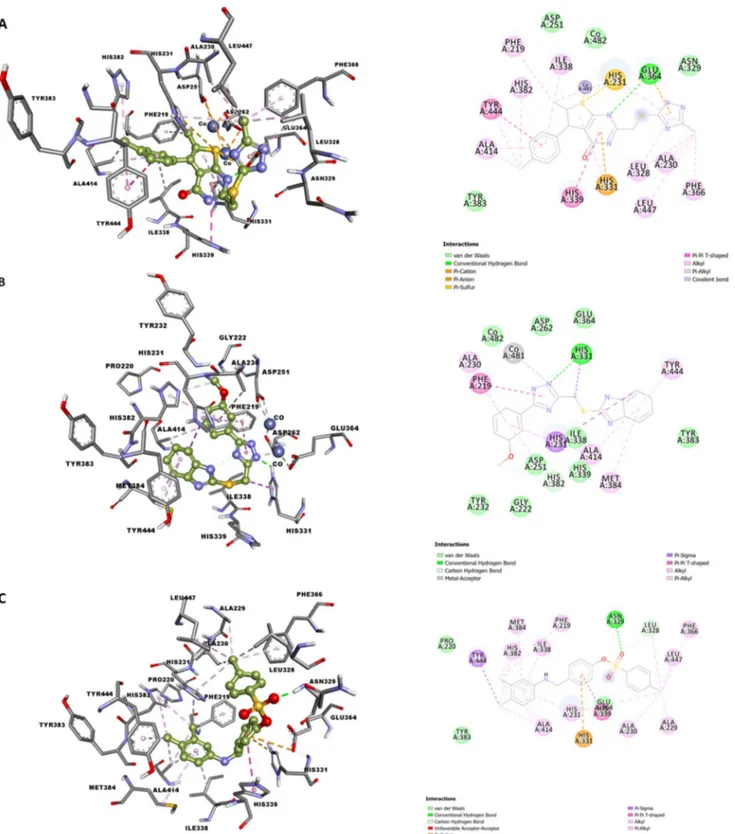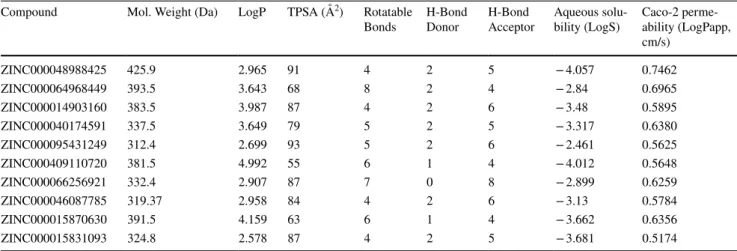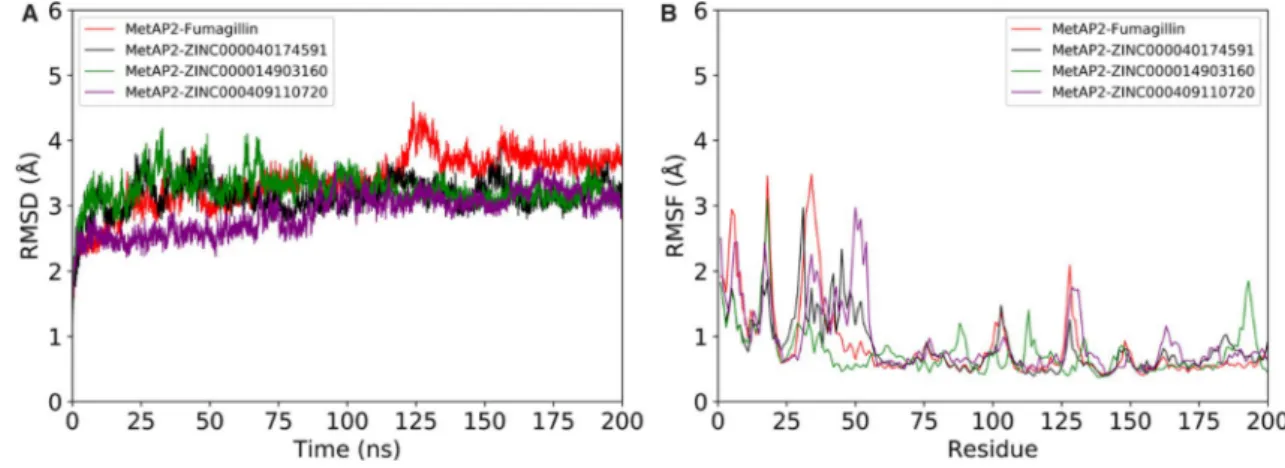https://doi.org/10.1007/s11030-021-10221-7
ORIGINAL ARTICLE
Potential inhibitors of methionine aminopeptidase type II identified
via structure‑based pharmacophore modeling
Safana Albayati1 · Abdullahi Ibrahim Uba1,2 · Kemal Yelekçi1
Received: 2 January 2021 / Accepted: 30 March 2021
© The Author(s), under exclusive licence to Springer Nature Switzerland AG 2021 Abstract
Methionine aminopeptidase (MetAP2) is a metal-containing enzyme that removes initiator methionine from the N-terminus of a newly synthesized protein. Inhibition of the enzyme is crucial in diminishing cancer growth and metastasis. Fumagillin—a natural irreversible inhibitor of MetAP2—and its derivatives are used as potent MetAP2 inhibitors. However, because of their adverse effects, none of them has progressed to clinical studies. In search for potential reversible inhibitors, we built structure-based pharmacophore models using the crystal structure of MetAP2 complexed with fumagillin (PDB ID: 1BOA). The phar-macophore models were validated using Gunner–Henry scoring method. The best pharphar-macophore consisting of 1 H-bond donor, 1 H-bond acceptor, and 3 hydrophobic features was used to conduct pharmacophore-based virtual screening of ZINC15 database against MetAP2. The top 10 compounds with pharmacophore fit values > 3.00 were selected for further analysis. These compounds were subjected to absorption, distribution, metabolism, elimination, and toxicity (ADMET) prediction and found to have druglike properties. Furthermore, molecular docking calculations was performed on these hits using AutoDock4 to predict their binding mode and binding energy. Three diverse compounds: ZINC000014903160, ZINC000040174591, and ZINC000409110720 with respective binding energy/docking scores of − 9.22, − 9.21, and −817 kcal/mol, were submitted to 100 ns (MD) simulations using Nanoscale MD (NAMD) software. The compounds showed stable binding mode over time. Therefore, they may serve as a scaffold for further computational and experimental optimization toward the design of more potent and safer MetAP2 inhibitors.
Graphic abstract
Safana Albayati and AbdullahiIbrahim Uba have contributed equally.
Keywords MetAP2 · Structure-based pharmacophore modeling · Docking · MD simulation · ADMET prediction · MetAP2 inhibitors
Introduction
Methionine aminopeptidase (MetAPs) is a metal-contain-ing enzyme that cleaves the N-terminal initiator methionine from a number of newly synthesized protein—this step is required for a correct protein folding and function [1]. There are three known mammalian MetAPs: MetAP1, MetAP2, and MetAP3 (MAP1D). MetAP1 and MetAP2 are found in eukaryotes, while MetAP1 is expressed in procaryotes. MetAP2 plays a critical role in the growth of new blood vessels (angiogenesis) in cancers [2], and regulation of adi-pose tissue in obesity through vasculature [3]. Fumagillin and its derivative TNP-470 are potent and selective natural inhibitors of MetAP2. Fumagillin and TNP470, potent and selective natural inhibitors of MetAP2, covalently bind to MetAP2 and block neovascularization via endothelial cell cycle arrest in the late G1 phase [1, 2, 4]. However, the U.S. Food and Drug Administration (FDA) found the biomol-ecule inadmissible in clinical trials due to its toxicity. To date, no drugs have been approved targeting MetAP2, hence active search for MetAP2 inhibitors is needed.
Studies have shown that rational drug design approach could be successfully applied to specifically target the enzyme for the treatment of cancers [5, 6], obesity [7–9], and other diseases. Toward this goal, combinations of com-putational and experimental methods have proven to be fast and effective [10, 11]. To treat obesity condition, Cheruval-lath and coworkers employed a combination of fragment-based and structure-fragment-based drug discovery methods to design potent (< 10 nM) indazoles that showed reversible MetAP2 inhibition at nanomolar concentration [12]. In continuation with their studies, the group derived more potent, selective, and orally available MetAP2 inhibitors from pyrazolo[4,3-b]indole core using SAR and accelerated knowledge-based fragment growth; and treatment with these inhibitors led to robust and sustainable body weight loss in DIO mice [13]. A potent and reversible MetAP-2 inhibitor, M8891, discovered via structure-based hit optimization, impeded the growth of primary endothelial cells and showed antitumoral activity in mouse models [14]. Recently, using a combined com-putational molecular design approach, our group identified potential MetAP2 inhibitors [15]. Therefore, these studies and more [16] show that computational methods are pow-erful tools that aid in the search for potent, selective, and reversible MetAP2 inhibitors; and their potential use to treat a variety of cancers, and obesity condition.
Here, in search for reversible inhibitors of MetAP2, structure-based pharmacophore models were built from the crystal structure of MetAP2 complexed with fumagillin
(PDB ID: 1BOA)[17], and validated using Güner–Henry scoring method [18]. The best model (hypothesis 1) was used to conduct pharmacophore-based virtual screen-ing of ZINC15 druglike database. Top hits with pharma-cophore fit values > 3.00 were studied using molecular docking. To examine the stability of ligand binding mode, MetAP2 complexes with fumagillin and diverse com-pound (ZINC000014903160, ZINC000040174591, and ZINC000409110720) from the top 10 hits were submitted to molecular dynamic simulation. These compounds were found to be stable in the active site of MetAP2, with similar orientation to that of the cocrystal ligand fumagillin. There-fore, we suggest these compounds to be potential MetAP2 inhibitors, subject to further computational and experimental optimization.
Methods
Structure‑based pharmacophore generation
Crystal structures of MetAP2 complexed with angiogenesis inhibitor fumagillin (PDB ID: 1BOA; Resolution: 1.80 Å [17] was retrieved from the protein data bank (PDB) [19]. The complex was prepared using the “Protein preparation toolkit” available in Biovia Discovery Studio 4.5. Subse-quently, 10 structure-based pharmacophore models (hypoth-eses) were built using “Receptor-based pharmacophore” generation toolkit of Biovia Discovery Studio 4.5. The phar-macophore models were subjected to evaluation as described in the following section.
Pharmacophore model validation
A total of 39 known MetAP2 inhibitors, whose experi-mental activity values and sources are shown in Table S1, were retrieved [20–32]. A total of 1842 inactive (decoys) compounds were generated using the Directory of Useful Decoys-Enhanced (http:// dude. docki ng. org/) [33]. Hence, a database containing 39 active and 1842 inactive molecules was built and used to evaluate the discriminative ability of the pharmacophore model in distinguishing active com-pounds from the inactive comcom-pounds. The database screen-ing was performed usscreen-ing the pharmacophore database search available in Biovia Discovery Studio 4.5. The Güner–Henry scoring method was used to evaluate the ability of the gen-erated models to selectively retrieve active molecules from a dataset containing known active and inactive molecules.
The following equation was used to compute the goodness-of-hit score:
The total hits is (Ht), number of active molecules (A), number of active hit (Ha), % active of actives (%A), yield of actives (%Y), enrichment factor (E), and goodness-of-hit score (GH). The GH score ranges from 0 to 1, which indi-cates a null model and an ideal model, respectively [18, 34].
Pharmacophore‑based virtual screening
Hypo1 consisting of 1 H-bond donors, 1 H-bond accep-tors, and 3 hydrophobic features (ADHHH) and Hypo2 consisting of 2 H-bond acceptors and 3 hydrophobic fea-tures (AAHHH), both from 1BOA complex, were found to have the highest GH score (0.92). A GH score between 0.6 and 1.00 suggests robustness of a pharmacophore hypoth-esis [18]. Hypo1 was selected based on feature diversity and used to conduct pharmacophore-based virtual screen-ing of ZINC15 database containscreen-ing over two hundred and 230,000,000 commercially available compounds, freely accessible for download [35]. To reduce this huge data-base to a manageable number, filtration was done data-based on “Lipinski’s rule of 5”: logP ≤ 5, molecular weight: 250 to 500 Da, number of H-bond donors ≤ 5; number of H-bond acceptors ≤ 10; [36], and number of rotatable bonds ≤ 4 [37]. A reduced database containing 6,000,000 compounds was built in Biovia DS 4.5, and Hypo1 was run against it. The top 10 compounds—all with pharmacophore fit value of > 3.00—were saved for further analysis.
Molecular docking
AutoDockTools [38] was used to assign partial charges to each atom to generate “protein.pdbqt”. The Zinc charge in this file was manually modified to + 2. Energy grid boxes of dimensions 70, 70, and 70 Å were used to cover the entire binding site of MetAP2 and its neighboring residues. The grid dimension was adopted from our previous study on computational identification of MetAP2 inhibitor [15]. %A =Ha A %Y = Ha Ht ∗ 100 E= Ha∕Ht A∕D GH=( Ha(2A + Ht) 4HtA ) ( 1− Ht− Ha D− A ) .
AutoDock 4.2′s Lamarckian genetic algorithm in Auto-Dock4 [38] was used for ligand conformational search, with 20 independent runs and 20,000,000 energy evaluations for each ligand.
Druglike and ADMET prediction
Even though the database was initially developed based on Druglikeness, further prediction based on Lipinski’s “Rule of 5” [36, 37], AdmetSAR server was used again to evaluate the top 10 hit compounds. This server calculates ADMET properties based on substructure pattern recognition using support vector machine algorithm [39].
Molecular dynamics simulation
The MetAP2 docking complexes with the pharmaco-phore best-fitting compounds (ZINC000014903160, ZINC000040174591, and ZINC000409110720) were pre-pared for MD simulation. As a control, the crystal structure of MetAP2 complexed with fumagillin (1BOA) was also prepared for MD simulation. Input files were generated using CHARMM-GUI server (http:// www. charmm. org)[40], via which the ligands were parameterized using CHARMM General Force Field (CGenFF) server (https:// cgenff. param chem. org/) [41]. MD simulation was performed using Nanoscale MD (NAMD) software [42]. For each system, the following simulation protocols were applied: 1000 steps of minimization by steepest descent method; 5 ns equilibra-tion in standard number of particles, volume, and tempera-ture (NVT) ensemble; and unrestrained 200 ns-production MD simulations in standard number of particles, pressure, and temperature (NPT) ensemble. The simulation was car-ried out at 2 fs time scale, and the trajectory frame was col-lected every 20 ps. To identify the most populated structure representing each system, the trajectories were clustered using RMSD cutoff of 2.5 Å in Chimera [43]. The stability of each system was assessed by computing the root mean-square deviation (RMSD) and root mean-mean-square fluctuation (RMSF) over the entire simulation period.
Results and discussion
Redocking of the cocrystal ligand
To validate the docking algorithm employed, the cocrys-tal ligand fumagillin was redocked into the active site of MetAP2 using docking procedure described in molecular docking subsection above. The docked and crystal poses of fumagillin overlaid in the active site of MetAP2, aligned well with each other with RMSD value of 0.92 Å (Fig. 1).
Pharmacophore models generated
The 10 pharmacophores hypotheses generated, their fea-tures, selectivity, and GH scores are given in Table 1. Hypothesis 1 (Hypo1) and hypothesis 2 (Hypo2) were found to have same GH score, despite consisting of different set of features. Hyop1 consists of 1 H-bond donors, 1 H-bond acceptors, and 3 hydrophobic features (ADHHH) and dis-played the highest selectivity (Fig. 2). A pharmacophore model with high selectivity tends to retrieve compounds that fit well protein binding pocket [44, 45].
Predicted binding affinity of best‑fitting compounds
The top 10 compounds were found to have pharmacophore fit values > 3.00. Compounds with pharmacophore fit val-ues > 3.00 have been shown by our previous data [45] and those of others [46] to have good inhibition potential against respective targets. The predicted binding affinities of the top 10 hit compounds are ranked from highest to lowest—in
comparison with that of the cocrystal ligand, fumagillin. The chemical structures of the diverse compounds are avail-able in the supplementary materials (Tavail-able S1). The binding affinity of the best pose out of 20 generated docking poses for each compound is presented in Table 2. Compounds sub-mitted to MD simulations were selected based on binding affinity and scaffold diversity.
Protein–Ligand interaction
Figure 2 shows the detailed interactions between MetAP2 and ZINC000014903160 (Fig. 3a), ZINC000040174591 (Fig. 3b), and ZINC000409110720 (Fig. 3c). The 3D and 2D representations are provided in the left and right pan-els, respectively. ZINC000014903160 spanned the active site of MetAP2 by forming strong metallic interaction with Co2+ ion via thiophene group; phi–cation interactions with
His231 and His331; H-bond with Glu364, several hydro-phobic interactions, and a couple of other interactions. The binding orientation of ZINC000014903160 and its
Fig. 1 Molecular overlay of the cocrystal ligand (Fumagillin) (Pink) with its docked pose (Green) in the active site of MetAP2. The RMSD between the crystal and docked poses is found to be 0.92 Å
Table 1 Pharmacophore models and validation
H-bond donor (D); H-bond acceptor (A), Hydrophobic feature (H), total hits (Ht), number of active mol-ecules (A), number of active hit (Ha), % active of actives (%A), yield of actives (%Y), enrichment factor (E), and goodness-of-hit score (GH). The GH score ranges from 0 to 1, which indicates a null model and an ideal model, respectively
Hypothesis Features Selectivity D A Ht Ha %A %Y E GH
1 ADHHH 8.9325 1881 39 31 30 76.92 96.77 46.674 0.917615711 2 AAHHH 8.0189 1881 39 31 30 76.92 96.77 46.674 0.917615711 3 ADHH 7.4177 1881 39 31 29 74.36 93.54 45.119 0.886546701 4 ADHH 7.4177 1881 39 38 31 79.49 81.57 39.346 0.80747975 5 ADHH 7.4177 1881 39 39 31 79.49 79.48 38.337 0.791419583 6 DHHH 7.4177 1881 39 39 30 76.92 76.92 37.101 0.765472313 7 AAHH 6.5041 1881 39 38 31 79.49 81.57 39.346 0.80747975 8 AAHH 6.5041 1881 39 34 28 71.79 82.35 39.719 0.79453771 9 AAHH 6.5041 1881 39 38 31 79.49 81.57 39.346 0.80747975 10 AHHH 6.5041 1881 39 34 30 76.923 88.23 42.557 0.852217735
interactions may be correct enough to stabilize the com-plex. In case of ZINC000409110720, the Co2+ ion was
engaged with imidazole group via metal–acceptor inter-action. Other types of interaction include a H-bond with His331, a couple of hydrophobic and van der Waal’s inter-actions, phi–phi T-shaped and phi–sigma interactions. Fore MetAP2- ZINC000409110720 complex, Co2+ ion was not
involved interactions—rather a strong H-bond was formed between the sulfonyl group and Asn329, and a phi–cation interaction between the central aromatic linker and His331. Other interactions include several hydrophobic interactions, a phi–phi T-shaped and a phi–sigma interaction. These inter-actions added up to give the overall strong binding affinity observed in these ligands.
Predicted ADMET and druglike properties
The top 10 hit compounds showed potentialities to be drug-like having obeyed Lipinski’s “Rule of 5” [36] and other physicochemical properties. All the physicochemical param-eters were found to be within the range of orally available drug molecules (Table 3). Caco-2 cells permeability is a model of human intestinal absorption of drugs and other compounds [47]. Aqueous solubility is an important phys-icochemical property that determines the uptake, and the distribution, metabolism, and elimination (ADME) charac-teristics of a molecule [48].
Figure 4 shows ADMET plot of PSA (polar surface area) versus AlogP98 (n-octanol–water the logarithm of the partition coefficient). The ellipses enclose regions where well-absorbed compounds are expected to be found. About 95 and 99% of well-absorbed compound are expected to be within the ellipses colored in red and
green, respectively, for intestinal absorption. Similarly, for the blood–brain barrier penetration, 95 and 99% of well-absorbed inhibitors are expected to fall within the ellipses colored with magenta and aqua, respectively. Here, all the 10 hits are enclosed inside all four ellipses, satisfying the conditions for absorption by the intestines and the brain.
Predicting and assessing the bioactivity of the 10 compounds
Bioactivity of a compound is essential for assessing lead-likeness of a compound. Bioactivity prediction was recently applied to study potential inhibitors of MetAP2 [15]. In this study, the following parameters were calcu-lated: ligand efficiency (LEF), LEF scale, fit quality (FQ), and LEF-dependent lipophilicity (LEFDL) (Table 4) [49].
NHA is the number of heavy atoms in a molecule. BF is the ratio of the binding affinity.
Scaling function (LEF scale) is derived by fitting an exponent function for maximizing LEF values observed for a given NHA count:
LEFScale = 0.873 × e−0.026×NHA – 0.064.
FQ is the quotient of the observed LEF and the LEF scale and is given by:
LEFDL is the ratio of the log p to the LEF computed as: LEF= −BF
NHA.
FQ= LEF LEF scale.
Fig. 2 The best pharmacophore hypotheses generated using 1BOA complex: H-bond donor (Purple); H-bond acceptor (Green); Hydrophobic feature (Cyan). Hyop1 consists of 1 H-bond donors, 1 H-bond acceptors, and 3 hydrophobic features (ADHHH)
Table 2 Calculated binding affinity of the best 10 compounds
Compound Structure Pharmacophore fit value ΔG (Kcal/mol)
Fumagillin 4.21 − 9.20 ZINC000048988425 3.98 − 10.01 ZINC000064968449 3.95 − 9.24 ZINC000014903160 3.92 − 9.22 ZINC000040174591 3.86 − 9.21 ZINC000095431249 3.84 − 8.49 ZINC000409110720 3.65 − 8.37 ZINC000066256921 3.33 − 8.19 ZINC000046087785 3.30 − 8.13
When LEF > 0.3, FQ score increases and the affinity of the final compound approaches near optimal state. An LEFDL value > 3 suggests optimal compound [49].
Molecular dynamics simulation
A total of 4 systems (MetAP2 complexes with fuma-gillin, and with 3 compounds: ZINC000014903160, ZINC000040174591, and ZINC000409110720) were submitted to unrestrained 200 MD simulation. These 3 hit compounds were selected from the top 10 best-fitting compounds based on structural diversity.
RMSD is a commonly used measure of similarity between two protein structures, which in turn suggests structural stability [50]. Here, all frames were aligned with the initial structure and the resulting RMSD was computed. The RMSD of the 4 systems varied between 0 and 4.2 Å until around 100 ns, and then converged to about 2.8 to 3.4 Å for the MetAP2 complexes with the 3 hit compounds until the end of the simulation. On the other hand, the MetAP2-fumagillin complex reached RMSD convergence (between 3.2 and 4.0 Å) beyond 130 ns (Fig. 5a). The backbone root mean-square fluc-tuation (RMSF) is a measure of the displacement of a par-ticular atom, or group of atoms (residue), relative to the LEFDL= log p
LEF .
reference structure, averaged over the number of atoms [51]. The RMSF is another parameter used to assess pro-tein structural stability. The RMSF profiles of all the sys-tems showed similar trends with the RMSD variations, although few residues away from the active site showed increased fluctuation (Fig. 5b). Therefore, these results suggest potentialities of the proposed compounds to form stable complexes with MetAP2.
Conclusion
Inhibition of MetAP2 has been shown to be promising for the treatment of cancers and obesity condition. In search for reversible MetAP2 inhibitors, structure-based pharmaco-phore models were developed and used to screen a ZINC15 database. The top hit compounds were filtered based on phar-macophore fit criteria (Fit value > 3.00). The 10 best-fitting compounds subjected to ADMET and bioactivity predic-tions were found to be druglike and efficient. Henceforth, 3 compounds (ZINC000014903160, ZINC000040174591, and ZINC000409110720) selected from the best-fitting com-pounds based on diversity were docked to the active site of MetAP2 and then subjected to all-atom MD simulation, with the crystal structure of MetAP2-fumagillin complex (1BOA) as positive control. These compounds demonstrate potential stability in the active site of MetAP2 over time. They may therefore serve as additional scaffolds for further optimization toward the design of more potent and safer MetAP2 inhibitors.
Table 2 (continued)
Compound Structure Pharmacophore fit value ΔG (Kcal/mol)
ZINC000015870630 3.21 − 8.11
Fig. 3 Interaction between MetAP2 and ligands. a ZINC000014903160. b ZINC000040174591. c ZINC000409110720. 3D and 2D interaction
Table 3 Predicted ADMET and druglike properties of the top 10 hit compounds
LogP (Octanol–water partition coefficient) ≤ 5; Molecular weight ≤ 500 Da; H-Bond Donor ≤ 5. H-Bond Acceptor ≤ 5. T_PSA (Topological polar surface area) ≤ 140 Å2. P(BBB +) (Probability for blood–brain barrier penetration). Aqueous solubility (LogS ≥ − 5.7). Caco-2 permeabil-ity > 22 nm/s
Compound Mol. Weight (Da) LogP TPSA (Å2) Rotatable
Bonds H-Bond Donor H-Bond Acceptor Aqueous solu-bility (LogS) Caco-2 perme-ability (LogPapp, cm/s) ZINC000048988425 425.9 2.965 91 4 2 5 − 4.057 0.7462 ZINC000064968449 393.5 3.643 68 8 2 4 − 2.84 0.6965 ZINC000014903160 383.5 3.987 87 4 2 6 − 3.48 0.5895 ZINC000040174591 337.5 3.649 79 5 2 5 − 3.317 0.6380 ZINC000095431249 312.4 2.699 93 5 2 6 − 2.461 0.5625 ZINC000409110720 381.5 4.992 55 6 1 4 − 4.012 0.5648 ZINC000066256921 332.4 2.907 87 7 0 8 − 2.899 0.6259 ZINC000046087785 319.37 2.958 84 4 2 6 − 3.13 0.5784 ZINC000015870630 391.5 4.159 63 6 1 4 − 3.662 0.6356 ZINC000015831093 324.8 2.578 87 4 2 5 − 3.681 0.5174
Fig. 4 Predicted ADMET and druglike properties of the top 10 hit compounds. All the 10 hits are enclosed inside all four ellipses, satisfying the conditions for absorption by the intestines and the brain
Supplementary Information The online version contains supplemen-tary material available at https:// doi. org/ 10. 1007/ s11030- 021- 10221-7.
Acknowledgments AIU and KY thank The Scientific and Technical Research Council of Turkey (TÜBITAK) for support.
Funding This work received no funding.
Declarations
Conflict of interest The authors indicate no potential conflicts of inter-est.
References
1. Griffith EC et al (1998) Molecular recognition of angiogenesis inhibitors fumagillin and ovalicin by methionine aminopepti-dase 2. Proc Natl Acad Sci 95(26):15183–15188. https:// doi. org/ 10. 1073/ pnas. 95. 26. 15183
2. O’Reilly MS, Brem H, Folkman J (1995) Treatment of murine hemangioendotheliomas with the angiogenesis inhibitor
AGM-1470. J Pediatr Surg 30(2):325–330. https:// doi. org/ 10. 1016/ 0022- 3468(95) 90583-9
3. Rupnick MA et al (2002) Adipose tissue mass can be regu-lated through the vasculature. Proc Natl Acad Sci U S A 99(16):10730–10735. https:// doi. org/ 10. 1073/ pnas. 16234 9799
4. Takamiya Y et al (1994) AGM-1470 inhibits the growth of human glioblastoma cells in vitro and in vivo. Neurosurgery 34(5):869–875. https:// doi. org/ 10. 1227/ 00006 123- 19940 5000- 00013
5. Yin SQ et al (2012) The development of MetAP-2 inhibitors in cancer treatment. Curr Med Chem 19(7):1021–1035. https:// doi. org/ 10. 2174/ 09298 67127 99320 709
6. Esa R et al (2020) The role of methionine Aminopeptidase 2 in Lymphangiogenesis. Int J Mol Sci. https:// doi. org/ 10. 3390/ ijms2 11451 48
7. McCandless SE et al (2017) Effects of MetAP2 inhibition on hyperphagia and body weight in Prader-Willi syndrome: a ran-domized, double-blind, placebo-controlled trial. Diabetes Obes Metab 19(12):1751–1761. https:// doi. org/ 10. 1111/ dom. 13021
8. Siddik MAB et al (2019) A MetAP2 inhibitor blocks adipogen-esis, yet improves glucose uptake in cells. Adipocyte 8(1):240– 253. https:// doi. org/ 10. 1080/ 21623 945. 2019. 16366 27
9. Proietto J et al (2018) Efficacy and safety of methionine ami-nopeptidase 2 inhibition in type 2 diabetes: a randomised,
Table 4 Bioactivity and efficiency parameters of the top 10 hit compounds
When LEF > 0.3, FQ score increases; the affinity of the final compound approaches near optimal affinity. An LEFDL value > 3 suggests optimal compound
Compound BF NHA LEF LEF Scale FQ LEFDL
ZINC000048988425 10.88 30 0.362667 0.336188448 1.078761 8.161757 ZINC000064968449 9.96 29 0.343448 0.346729791 0.990535 10.5984 ZINC000014903160 9.31 26 0.358077 0.380049284 0.942186 11.13448 ZINC000040174591 9.75 24 0.40625 0.403750744 1.00619 8.982154 ZINC000095431249 9.02 22 0.41 0.428717287 0.956341 6.582927 ZINC000409110720 9.77 27 0.361852 0.368652799 0.981552 13.7957 ZINC000066256921 9.91 23 0.43087 0.416071742 1.035567 6.746815 ZINC000046087785 9.03 24 0.37625 0.403750744 0.931887 7.861794 ZINC000015870630 10.65 28 0.380357 0.357548803 1.06379 10.93446 ZINC000015831093 9.02 21 0.429524 0.441695928 0.972443 6.001993
Fig. 5 Molecular dynamics simulation of MetAP2 in complex with fumagillin, ZINC000014903160, ZINC000040174591, and ZINC000409110720: (A) Root mean-square deviation (RMSD) (B) Root mean-square fluctuation (RMSF)
placebo-controlled clinical trial. Diabetologia 61(9):1918–1922.
https:// doi. org/ 10. 1007/ s00125- 018- 4677-0
10. Han Mİ et al (2019) Synthesis, molecular modeling, in vivo study, and anticancer activity of 1,2,4-triazole containing hydrazide– hydrazones derived from ( S)-naproxen. Archiv der Pharmazie.
https:// doi. org/ 10. 1002/ ardp. 20180 0365
11. Yılmaz Ö et al (2020) Synthesis, anticancer activity on prostate cancer cell lines and molecular modeling studies of flurbiprofen-thioether derivatives as potential target of metap (type II). Med Chem 16(6):735–749. https:// doi. org/ 10. 2174/ 15734 06415 66619 06131 62322
12. Cheruvallath Z et al (2016) Discovery of potent, revers-ible MetAP2 inhibitors via fragment based drug discovery and structure based drug design—part 1. Bioorg Med Chem Lett 26(12):2774–2778. https:// doi. org/ 10. 1016/j. bmcl. 2016. 04. 073
13. McBride C et al (2016) Discovery of potent, reversible MetAP2 inhibitors via fragment based drug discovery and structure based drug design-Part 2. Bioorg Med Chem Lett 26(12):2779–2783.
https:// doi. org/ 10. 1016/j. bmcl. 2016. 04. 072
14. Heinrich T et al (2019) Identification of Methionine Aminopepti-dase-2 (MetAP-2) Inhibitor M8891: a clinical compound for the treatment of cancer. J Med Chem 62(24):11119–11134. https:// doi. org/ 10. 1021/ acs. jmedc hem. 9b010 70
15. Weako J et al (2020) Identification of potential inhibitors of human methionine aminopeptidase (type II) for cancer therapy: structure-based virtual screening, ADMET prediction and molecular dynam-ics studies. Comput Biol Chem. https:// doi. org/ 10. 1016/j. compb iolch em. 2020. 107244
16. Heinrich T et al (2017) Novel reversible methionine aminopepti-dase-2 (MetAP-2) inhibitors based on purine and related bicyclic templates. Bioorg Med Chem Lett 27(3):551–556
17. Liu S et al (1998) Structure of human methionine aminopeptidase-2 complexed with fumagillin. Science 282(5392):1324–1327. https:// doi. org/ 10. 1016/j. bmcl. 2016. 12. 019
18. Guner O, Clement O, Kurogi Y (2004) Pharmacophore modeling and three dimensional database searching for drug design using cata-lyst: recent advances. Curr Med Chem 11(22):2991–3005. https:// doi. org/ 10. 2174/ 09298 67043 364036
19. Berman HM et al (2000) The protein data bank. Nucleic Acids Res 28(1):235–242
20. Çoruh I et al (2018) Synthesis, anticancer activity, and molecular modeling of etodolac-thioether derivatives as potent methionine aminopeptidase (type II) inhibitors. Archiv der Pharmazie. https:// doi. org/ 10. 1093/ nar/ 28.1. 235
21. Liu T et al (2010) Differential expression profiles of alternaria alter-nate genes in response to carbonyl sulfide fumigation. J Microbiol 48(4):480–485. https:// doi. org/ 10. 1007/ s12275- 010- 9301-z
22. Kusaka M et al (1991) Potent anti-angiogenic action of AGM-1470: comparison to the fumagillin parent. Biochem Biophys Res Com-mun 174(3):1070–1076. https:// doi. org/ 10. 1016/ 0006- 291x(91) 91529-l
23. Arico-Muendel CC et al (2009) Carbamate analogues of fumagillin as potent, targeted inhibitors of methionine aminopeptidase-2. J Med Chem 52(24):8047–8056. https:// doi. org/ 10. 1021/ jm901 260k
24. Kass DJ et al (2012) Early treatment with fumagillin, an inhibitor of methionine aminopeptidase-2, prevents pulmonary hypertension in monocrotaline-injured rats. PLoS ONE 7(4):e35388. https:// doi. org/ 10. 1371/ journ al. pone. 00353 88
25. Ehlers T et al (2016) Methionine aminopeptidase type-2 inhibitors targeting angiogenesis. Curr Top Med Chem 16(13):1478–1488.
https:// doi. org/ 10. 2174/ 15680 26615 66615 09151 21204
26. Bernier SG et al (2004) A methionine aminopeptidase-2 inhibitor, PPI-2458, for the treatment of rheumatoid arthritis. Proc Natl Acad Sci U S A 101(29):10768–10773. https:// doi. org/ 10. 1073/ pnas. 04041 05101
27. Sheppard GS et al (2004) 3-Amino-2-hydroxyamides and related compounds as inhibitors of methionine aminopeptidase-2. Bioorg Med Chem Lett 14(4):865–868
28. Kallander LS et al (2005) 4-Aryl-1,2,3-triazole: a novel template for a reversible methionine aminopeptidase 2 inhibitor, optimized to inhibit angiogenesis in vivo. J Med Chem 48(18):5644–5647.
https:// doi. org/ 10. 1016/j. bmcl. 2003. 12. 031
29. Wang GT et al (2007) Lead optimization of methionine aminopepti-dase-2 (MetAP2) inhibitors containing sulfonamides of 5,6-disubsti-tuted anthranilic acids. Bioorg Med Chem Lett 17(10):2817–2822.
https:// doi. org/ 10. 1016/j. bmcl. 2007. 02. 062
30. Kawai M et al (2006) Development of sulfonamide compounds as potent methionine aminopeptidase type II inhibitors with antipro-liferative properties. Bioorg Med Chem Lett 16(13):3574–3577.
https:// doi. org/ 10. 1016/j. bmcl. 2006. 03. 085
31. Marino JP Jr et al (2007) Highly potent inhibitors of methionine aminopeptidase-2 based on a 1,2,4-triazole pharmacophore. J Med Chem 50(16):3777–3785. https:// doi. org/ 10. 1021/ jm061 182w
32. Morgen M et al (2016) Spiroepoxytriazoles are fumagillin-like irre-versible inhibitors of MetAP2 with potent cellular activity. ACS Chem Biol 11(4):1001–1011. https:// doi. org/ 10. 1021/ acsch embio. 5b007 55
33. Mysinger MM et al (2012) Directory of useful decoys, enhanced (DUD-E): better ligands and decoys for better benchmarking. J Med Chem 55(14):6582–6594. https:// doi. org/ 10. 1021/ jm300 687e
34. Kurogi Y, Guner O (2001) Pharmacophore modeling and three-dimensional database searching for drug design using catalyst. Curr Med Chem 8(9):1035–1055. https:// doi. org/ 10. 2174/ 09298 67043 364036
35. Sterling T, Irwin JJ (2015) ZINC 15 – ligand discovery for everyone. J Chem Inf Model 55(11):2324–2337. https:// doi. org/ 10. 1021/ acs. jcim. 5b005 59
36. Lipinski CA (2004) Lead- and drug-like compounds: the rule-of-five revolution. Drug Discov Today Technol 1(4):337–341. https:// doi. org/ 10. 1016/j. ddtec. 2004. 11. 007
37. Bhal SK et al (2007) The rule of five revisited: applying log D in place of log P in drug-likeness filters. Mol Pharm 4(4):556–560.
https:// doi. org/ 10. 1021/ mp070 0209
38. Morris GM et al (2009) AutoDock4 and AutoDockTools4: auto-mated docking with selective receptor flexibility. J Comput Chem 30(16):2785–2791. https:// doi. org/ 10. 1002/ jcc. 21256
39. Yang H et al (2019) admetSAR : web-service for prediction and optimization of chemical ADMET properties. Bioinformatics 35(6):1067–1069. https:// doi. org/ 10. 1093/ bioin forma tics/ bty707
40. Lee J et al (2015) CHARMM-GUI input generator for NAMD, GROMACS, AMBER, OpenMM, and CHARMM/OpenMM simu-lations using the CHARMM36 additive force field. J Chem Theory Comput 12(1):405–413. https:// doi. org/ 10. 1021/ acs. jctc. 5b009 35
41. Kim S et al (2017) CHARMM-GUI ligand reader and modeler for CHARMM force field generation of small molecules. J Comput Chem 38(21):1879–1886. https:// doi. org/ 10. 1002/ jcc. 24829
42. Phillips JC et al (2005) Scalable molecular dynamics with NAMD. J Comput Chem 26(16):1781–1802. https:// doi. org/ 10. 1002/ jcc. 20289
43. Pettersen EF et al (2004) UCSF chimera—a visualization system for exploratory research and analysis. J Comput Chem 25(13):1605– 1612. https:// doi. org/ 10. 1002/ jcc. 20084
44. Ahmed HEA, Zayed MF, Ihmaid S (2015) Molecular pharmaco-phore selectivity studies, virtual screening, and in silico ADMET analysis of GPCR antagonists. Med Chem Res 24(9):3537–3550.
https:// doi. org/ 10. 1007/ s00044- 015- 1389-6
45. Uba AI, Yelekçi K (2018) Pharmacophore-based virtual screening for identification of potential selective inhibitors of human histone deacetylase 6. Comput Biol Chem 77:318–330. https:// doi. org/ 10. 1016/j. compb iolch em. 2018. 10. 016
46. Sakkiah S et al (2014) Dynamic and multi-pharmacophore modeling for designing polo-box domain inhibitors. PLoS ONE 9(7):e101405.
https:// doi. org/ 10. 1371/ journ al. pone. 01014 05
47. van Breemen RB, Li Y (2005) Caco-2 cell permeability assays to measure drug absorption. Expert Opin Drug Metab Toxicol 1(2):175–185. https:// doi. org/ 10. 1517/ 17425 255.1. 2. 175
48. Hewitt M et al (2009) In silico prediction of aqueous solubility: the solubility challenge. J Chem Inf Model 49(11):2572–2587. https:// doi. org/ 10. 1021/ ci900 286s
49. Schultes S et al (2010) Ligand efficiency as a guide in fragment hit selection and optimization. Drug Discov Today Technol 7(3):e157– e162. https:// doi. org/ 10. 1016/j. ddtec. 2010. 11. 003
50. Uba AI et al (2019) Examining the stability of binding modes of the co-crystallized inhibitors of human HDAC8 by molecular dynamics simulation. J Biomol Struct Dyn. https:// doi. org/ 10. 1080/ 07391 102. 2019. 16159 89
51. Kleinjung J, Martínez L (2015) Automatic identification of mobile and rigid substructures in molecular dynamics simulations and frac-tional structural fluctuation analysis. Plos One. https:// doi. org/ 10. 1371/ journ al. pone. 01192 64
Publisher’s Note Springer Nature remains neutral with regard to jurisdictional claims in published maps and institutional affiliations.
Authors and Affiliations
Safana Albayati1 · Abdullahi Ibrahim Uba1,2 · Kemal Yelekçi1
* Kemal Yelekçi yelekci@khas.edu.tr
1 Department of Bioinformatics and Genetics, Faculty of Engineering and Natural Science, Kadir Has University, 34083 Cibali Campus Fatih, Istanbul, Turkey
2 Complex Systems Division, Beijing Computational Science Research Center, Beijing 100193, China
